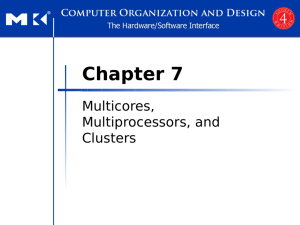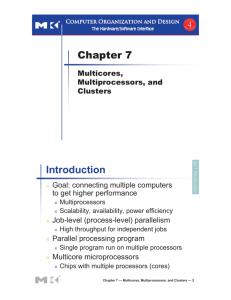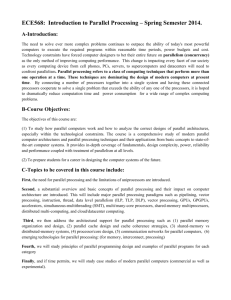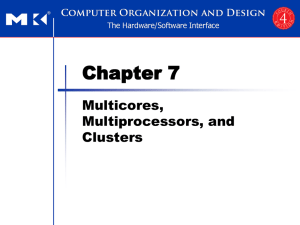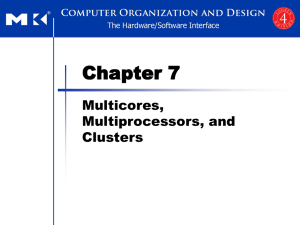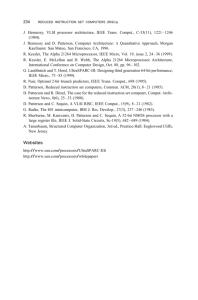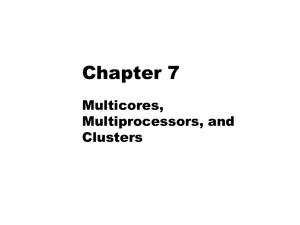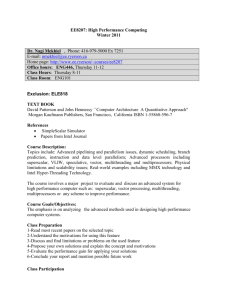Chapter 7
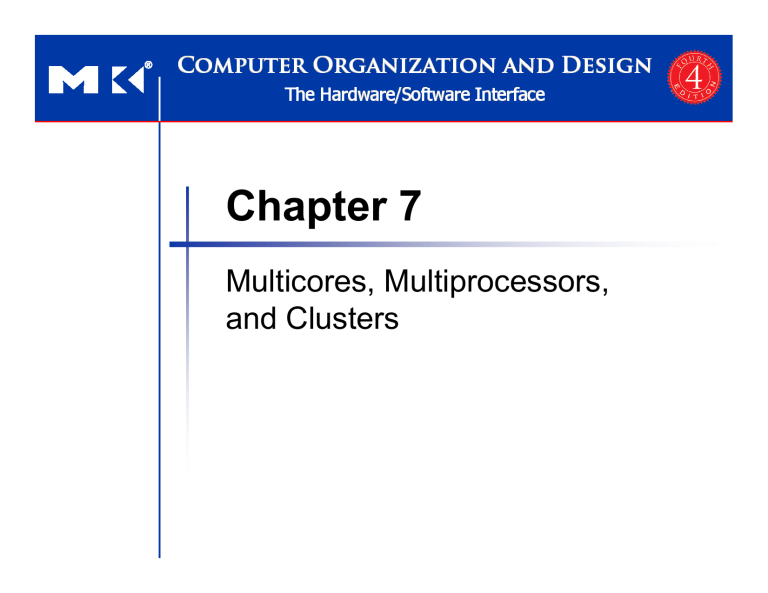
Chapter 7
Multicores, Multiprocessors, and Clusters
Introduction
Goal: connecting multiple computers to get higher performance
Multiprocessors
Scalability, availability, power efficiency
Job-level (process-level) parallelism
High throughput for independent jobs
Parallel processing program
Single program run on multiple processors
Multicore microprocessors
Chips with multiple processors (cores)
Chapter 7 — Multicores, Multiprocessors, and Clusters — 2
Hardware and Software
Hardware
Serial: e.g., Pentium 4
Parallel: e.g., quad-core Xeon e5345
Software
Sequential: e.g., matrix multiplication
Concurrent: e.g., operating system
Sequential/concurrent software can run on serial/parallel hardware
Challenge: making effective use of parallel hardware
Chapter 7 — Multicores, Multiprocessors, and Clusters — 3
What We’ve Already Covered
§2.11: Parallelism and Instructions
Synchronization
§3.6: Parallelism and Computer Arithmetic
Associativity
§4.10: Parallelism and Advanced
Instruction-Level Parallelism
§5.8: Parallelism and Memory Hierarchies
Cache Coherence
§6.9: Parallelism and I/O:
Redundant Arrays of Inexpensive Disks
Chapter 7 — Multicores, Multiprocessors, and Clusters — 4
Parallel Programming
Parallel software is the problem
Need to get significant performance improvement
Otherwise, just use a faster uniprocessor, since it’s easier!
Difficulties
Partitioning
Coordination
Communications overhead
Chapter 7 — Multicores, Multiprocessors, and Clusters — 5
Amdahl’s Law
Sequential part can limit speedup
Example: 100 processors, 90× speedup?
T new
= T parallelizable
/100 + T sequential
1
Speedup =
(1 − F paralleliz able
) + F paralleliz able
/100
= 90
Solving: F parallelizable
= 0.999
Need sequential part to be 0.1% of original time
Chapter 7 — Multicores, Multiprocessors, and Clusters — 6
Scaling Example
Workload: sum of 10 scalars, and 10 × 10 matrix sum
Speed up from 10 to 100 processors
Single processor: Time = (10 + 100) × t add
10 processors
Time = 10 × t add
+ 100/10 × t add
= 20 × t add
Speedup = 110/20 = 5.5 (55% of potential)
100 processors
Time = 10 × t add
+ 100/100 × t add
= 11 × t add
Speedup = 110/11 = 10 (10% of potential)
Assumes load can be balanced across processors
Chapter 7 — Multicores, Multiprocessors, and Clusters — 7
Scaling Example (cont)
What if matrix size is 100 × 100?
Single processor: Time = (10 + 10000) × t add
10 processors
Time = 10 × t add
+ 10000/10 × t add
= 1010 × t add
Speedup = 10010/1010 = 9.9 (99% of potential)
100 processors
Time = 10 × t add
+ 10000/100 × t add
= 110 × t add
Speedup = 10010/110 = 91 (91% of potential)
Assuming load balanced
Chapter 7 — Multicores, Multiprocessors, and Clusters — 8
Strong vs Weak Scaling
Strong scaling: problem size fixed
As in example
Weak scaling: problem size proportional to number of processors
10 processors, 10 × 10 matrix
Time = 20 × t add
100 processors, 32 × 32 matrix
Time = 10 × t add
+ 1000/100 × t add
= 20 × t add
Constant performance in this example
Chapter 7 — Multicores, Multiprocessors, and Clusters — 9
Shared Memory
SMP: shared memory multiprocessor
Hardware provides single physical address space for all processors
Synchronize shared variables using locks
Memory access time
UMA (uniform) vs. NUMA (nonuniform)
Chapter 7 — Multicores, Multiprocessors, and Clusters — 10
Example: Sum Reduction
Sum 100,000 numbers on 100 processor UMA
Each processor has ID: 0 ≤ Pn ≤ 99
Partition 1000 numbers per processor
Initial summation on each processor sum[Pn] = 0; for (i = 1000*Pn; i < 1000*(Pn+1); i = i + 1) sum[Pn] = sum[Pn] + A[i];
Now need to add these partial sums
Reduction: divide and conquer
Half the processors add pairs, then quarter, …
Need to synchronize between reduction steps
Chapter 7 — Multicores, Multiprocessors, and Clusters — 11
Example: Sum Reduction
half = 100; repeat synch(); if (half%2 != 0 && Pn == 0) sum[0] = sum[0] + sum[half-1];
/* Conditional sum needed when half is odd;
Processor0 gets missing element */ half = half/2; /* dividing line on who sums */ if (Pn < half) sum[Pn] = sum[Pn] + sum[Pn+half]; until (half == 1);
Chapter 7 — Multicores, Multiprocessors, and Clusters — 12
Message Passing
Each processor has private physical address space
Hardware sends/receives messages between processors
Chapter 7 — Multicores, Multiprocessors, and Clusters — 13
Loosely Coupled Clusters
Network of independent computers
Each has private memory and OS
Connected using I/O system
E.g., Ethernet/switch, Internet
Suitable for applications with independent tasks
Web servers, databases, simulations, …
High availability, scalable, affordable
Problems
Administration cost (prefer virtual machines)
Low interconnect bandwidth c.f. processor/memory bandwidth on an SMP
Chapter 7 — Multicores, Multiprocessors, and Clusters — 14
Sum Reduction (Again)
Sum 100,000 on 100 processors
First distribute 100 numbers to each
The do partial sums sum = 0; for (i = 0; i<1000; i = i + 1) sum = sum + AN[i];
Reduction
Half the processors send, other half receive and add
The quarter send, quarter receive and add, …
Chapter 7 — Multicores, Multiprocessors, and Clusters — 15
Sum Reduction (Again)
Given send() and receive() operations limit = 100; half = 100;/* 100 processors */ repeat half = (half+1)/2; /* send vs. receive dividing line */ if (Pn >= half && Pn < limit) send(Pn - half, sum) ; if (Pn < (limit/2)) sum = sum + receive() ; limit = half; /* upper limit of senders */ until (half == 1); /* exit with final sum */
Send/receive also provide synchronization
Assumes send/receive take similar time to addition
Chapter 7 — Multicores, Multiprocessors, and Clusters — 16
Grid Computing
Separate computers interconnected by long-haul networks
E.g., Internet connections
Work units farmed out, results sent back
Can make use of idle time on PCs
E.g., SETI@home, World Community Grid
Chapter 7 — Multicores, Multiprocessors, and Clusters — 17
Multithreading
Performing multiple threads of execution in parallel
Replicate registers, PC, etc.
Fast switching between threads
Fine-grain multithreading
Switch threads after each cycle
Interleave instruction execution
If one thread stalls, others are executed
Coarse-grain multithreading
Only switch on long stall (e.g., L2-cache miss)
Simplifies hardware, but doesn’t hide short stalls
(eg, data hazards)
Chapter 7 — Multicores, Multiprocessors, and Clusters — 18
Simultaneous Multithreading
In multiple-issue dynamically scheduled processor
Schedule instructions from multiple threads
Instructions from independent threads execute when function units are available
Within threads, dependencies handled by scheduling and register renaming
Example: Intel Pentium-4 HT
Two threads: duplicated registers, shared function units and caches
Chapter 7 — Multicores, Multiprocessors, and Clusters — 19
Multithreading Example
Chapter 7 — Multicores, Multiprocessors, and Clusters — 20
Future of Multithreading
Will it survive? In what form?
Power considerations ⇒ simplified microarchitectures
Simpler forms of multithreading
Tolerating cache-miss latency
Thread switch may be most effective
Multiple simple cores might share resources more effectively
Chapter 7 — Multicores, Multiprocessors, and Clusters — 21
Instruction and Data Streams
An alternate classification
Instruction
Streams
Single
Multiple
SISD :
Intel Pentium 4
MISD :
Single
Data Streams
No examples today
Multiple
SIMD : SSE instructions of x86
MIMD :
Intel Xeon e5345
SPMD: Single Program Multiple Data
A parallel program on a MIMD computer
Conditional code for different processors
Chapter 7 — Multicores, Multiprocessors, and Clusters — 22
SIMD
Operate elementwise on vectors of data
E.g., MMX and SSE instructions in x86
Multiple data elements in 128-bit wide registers
All processors execute the same instruction at the same time
Each with different data address, etc.
Simplifies synchronization
Reduced instruction control hardware
Works best for highly data-parallel applications
Chapter 7 — Multicores, Multiprocessors, and Clusters — 23
Vector Processors
Highly pipelined function units
Stream data from/to vector registers to units
Data collected from memory into registers
Results stored from registers to memory
Example: Vector extension to MIPS
32 × 64-element registers (64-bit elements)
Vector instructions lv , sv : load/store vector addv.d
: add vectors of double addvs.d
: add scalar to each element of vector of double
Significantly reduces instruction-fetch bandwidth
Chapter 7 — Multicores, Multiprocessors, and Clusters — 24
Example: DAXPY (Y = a × X + Y)
Conventional MIPS code l.d
$f0,a($sp) ;load scalar a addiu r4,$s0,#512 ;upper bound of what to load loop: l.d
$f2,0($s0) ;load x(i) mul.d $f2,$f2,$f0 ;a × x(i) l.d
$f4,0($s1) ;load y(i) add.d $f4,$f4,$f2 ;a × x(i) + y(i) s.d
$f4,0($s1) ;store into y(i) addiu $s0,$s0,#8 ;increment index to x addiu $s1,$s1,#8 ;increment index to y subu $t0,r4,$s0 ;compute bound bne $t0,$zero,loop ;check if done
Vector MIPS code l.d
lv
$f0,a($sp) ;load scalar a
$v1,0($s0) ;load vector x mulvs.d $v2,$v1,$f0 ;vector-scalar multiply lv $v3,0($s1) ;load vector y addv.d
$v4,$v2,$v3 ;add y to product sv $v4,0($s1) ;store the result
Chapter 7 — Multicores, Multiprocessors, and Clusters — 25
Vector vs. Scalar
Vector architectures and compilers
Simplify data-parallel programming
Explicit statement of absence of loop-carried dependences
Reduced checking in hardware
Regular access patterns benefit from interleaved and burst memory
Avoid control hazards by avoiding loops
More general than ad-hoc media extensions (such as MMX, SSE)
Better match with compiler technology
Chapter 7 — Multicores, Multiprocessors, and Clusters — 26
History of GPUs
Early video cards
Frame buffer memory with address generation for video output
3D graphics processing
Originally high-end computers (e.g., SGI)
Moore’s Law ⇒ lower cost, higher density
3D graphics cards for PCs and game consoles
Graphics Processing Units
Processors oriented to 3D graphics tasks
Vertex/pixel processing, shading, texture mapping, rasterization
Chapter 7 — Multicores, Multiprocessors, and Clusters — 27
Graphics in the System
Chapter 7 — Multicores, Multiprocessors, and Clusters — 28
GPU Architectures
Processing is highly data-parallel
GPUs are highly multithreaded
Use thread switching to hide memory latency
Less reliance on multi-level caches
Graphics memory is wide and high-bandwidth
Trend toward general purpose GPUs
Heterogeneous CPU/GPU systems
CPU for sequential code, GPU for parallel code
Programming languages/APIs
DirectX, OpenGL
C for Graphics (Cg), High Level Shader Language
(HLSL)
Compute Unified Device Architecture (CUDA)
Chapter 7 — Multicores, Multiprocessors, and Clusters — 29
Example: NVIDIA Tesla
Streaming multiprocessor
8 × Streaming processors
Chapter 7 — Multicores, Multiprocessors, and Clusters — 30
Example: NVIDIA Tesla
Streaming Processors
Single-precision FP and integer units
Each SP is fine-grained multithreaded
Warp: group of 32 threads
Executed in parallel,
SIMD style
8 SPs
× 4 clock cycles
Hardware contexts for 24 warps
Registers, PCs, …
Chapter 7 — Multicores, Multiprocessors, and Clusters — 31
Classifying GPUs
Don’t fit nicely into SIMD/MIMD model
Conditional execution in a thread allows an illusion of MIMD
But with performance degredation
Need to write general purpose code with care
Static: Discovered at Compile Time
VLIW
Dynamic: Discovered at Runtime
Superscalar Instruction-Level
Parallelism
Data-Level
Parallelism
SIMD or Vector Tesla Multiprocessor
Chapter 7 — Multicores, Multiprocessors, and Clusters — 32
Interconnection Networks
Network topologies
Arrangements of processors, switches, and links
Bus Ring
2D Mesh
N-cube (N = 3)
Fully connected
Chapter 7 — Multicores, Multiprocessors, and Clusters — 33
Multistage Networks
Chapter 7 — Multicores, Multiprocessors, and Clusters — 34
Network Characteristics
Performance
Latency per message (unloaded network)
Throughput
Link bandwidth
Total network bandwidth
Bisection bandwidth
Congestion delays (depending on traffic)
Cost
Power
Routability in silicon
Chapter 7 — Multicores, Multiprocessors, and Clusters — 35
Parallel Benchmarks
Linpack: matrix linear algebra
SPECrate: parallel run of SPEC CPU programs
Job-level parallelism
SPLASH: Stanford Parallel Applications for
Shared Memory
Mix of kernels and applications, strong scaling
NAS (NASA Advanced Supercomputing) suite computational fluid dynamics kernels
PARSEC (Princeton Application Repository for
Shared Memory Computers) suite
Multithreaded applications using Pthreads and
OpenMP
Chapter 7 — Multicores, Multiprocessors, and Clusters — 36
Code or Applications?
Traditional benchmarks
Fixed code and data sets
Parallel programming is evolving
Should algorithms, programming languages, and tools be part of the system?
Compare systems, provided they implement a given application
E.g., Linpack, Berkeley Design Patterns
Would foster innovation in approaches to parallelism
Chapter 7 — Multicores, Multiprocessors, and Clusters — 37
Modeling Performance
Assume performance metric of interest is achievable GFLOPs/sec
Measured using computational kernels from
Berkeley Design Patterns
Arithmetic intensity of a kernel
FLOPs per byte of memory accessed
For a given computer, determine
Peak GFLOPS (from data sheet)
Peak memory bytes/sec (using Stream benchmark)
Chapter 7 — Multicores, Multiprocessors, and Clusters — 38
Roofline Diagram
Attainable GPLOPs/sec
= Max ( Peak Memory BW × Arithmetic Intensity, Peak FP Performance )
Chapter 7 — Multicores, Multiprocessors, and Clusters — 39
Comparing Systems
Example: Opteron X2 vs. Opteron X4
2-core vs. 4-core, 2× FP performance/core, 2.2GHz vs. 2.3GHz
Same memory system
To get higher performance on X4 than X2
Need high arithmetic intensity
Or working set must fit in X4’s
2MB L-3 cache
Chapter 7 — Multicores, Multiprocessors, and Clusters — 40
Optimizing Performance
Optimize FP performance
Balance adds & multiplies
Improve superscalar ILP and use of SIMD instructions
Optimize memory usage
Software prefetch
Avoid load stalls
Memory affinity
Avoid non-local data accesses
Chapter 7 — Multicores, Multiprocessors, and Clusters — 41
Optimizing Performance
Choice of optimization depends on arithmetic intensity of code
Arithmetic intensity is not always fixed
May scale with problem size
Caching reduces memory accesses
Increases arithmetic intensity
Chapter 7 — Multicores, Multiprocessors, and Clusters — 42
Four Example Systems
2 × quad-core
Intel Xeon e5345
(Clovertown)
2 × quad-core
AMD Opteron X4 2356
(Barcelona)
Chapter 7 — Multicores, Multiprocessors, and Clusters — 43
Four Example Systems
2 × oct-core
Sun UltraSPARC
T2 5140 (Niagara 2)
2 × oct-core
IBM Cell QS20
Chapter 7 — Multicores, Multiprocessors, and Clusters — 44
And Their Rooflines
Kernels
SpMV (left)
LBHMD (right)
Some optimizations change arithmetic intensity x86 systems have higher peak GFLOPs
But harder to achieve, given memory bandwidth
Chapter 7 — Multicores, Multiprocessors, and Clusters — 45
Performance on SpMV
Sparse matrix/vector multiply
Irregular memory accesses, memory bound
Arithmetic intensity
0.166 before memory optimization, 0.25 after
Xeon vs. Opteron
Similar peak FLOPS
Xeon limited by shared FSBs and chipset
UltraSPARC/Cell vs. x86
20 – 30 vs. 75 peak GFLOPs
More cores and memory bandwidth
Chapter 7 — Multicores, Multiprocessors, and Clusters — 46
Performance on LBMHD
Fluid dynamics: structured grid over time steps
Each point: 75 FP read/write, 1300 FP ops
Arithmetic intensity
0.70 before optimization, 1.07 after
Opteron vs. UltraSPARC
More powerful cores, not limited by memory bandwidth
Xeon vs. others
Still suffers from memory bottlenecks
Chapter 7 — Multicores, Multiprocessors, and Clusters — 47
Achieving Performance
Compare naïve vs. optimized code
If naïve code performs well, it’s easier to write high performance code for the system
System Kernel
Intel Xeon
AMD
Opteron X4
Sun UltraSPARC
T2
IBM Cell QS20
SpMV
LBMHD
SpMV
LBMHD
SpMV
LBMHD
SpMV
LBMHD
Naïve
GFLOPs/sec
1.0
4.6
1.4
7.1
3.5
9.7
Naïve code not feasible
Optimized
GFLOPs/sec
1.5
5.6
3.6
14.1
4.1
10.5
6.4
16.7
Naïve as % of optimized
64%
82%
38%
50%
86%
93%
0%
0%
Chapter 7 — Multicores, Multiprocessors, and Clusters — 48
Fallacies
Amdahl’s Law doesn’t apply to parallel computers
Since we can achieve linear speedup
But only on applications with weak scaling
Peak performance tracks observed performance
Marketers like this approach!
But compare Xeon with others in example
Need to be aware of bottlenecks
Chapter 7 — Multicores, Multiprocessors, and Clusters — 49
Pitfalls
Not developing the software to take account of a multiprocessor architecture
Example: using a single lock for a shared composite resource
Serializes accesses, even if they could be done in parallel
Use finer-granularity locking
Chapter 7 — Multicores, Multiprocessors, and Clusters — 50
Concluding Remarks
Goal: higher performance by using multiple processors
Difficulties
Developing parallel software
Devising appropriate architectures
Many reasons for optimism
Changing software and application environment
Chip-level multiprocessors with lower latency, higher bandwidth interconnect
An ongoing challenge for computer architects!
Chapter 7 — Multicores, Multiprocessors, and Clusters — 51
